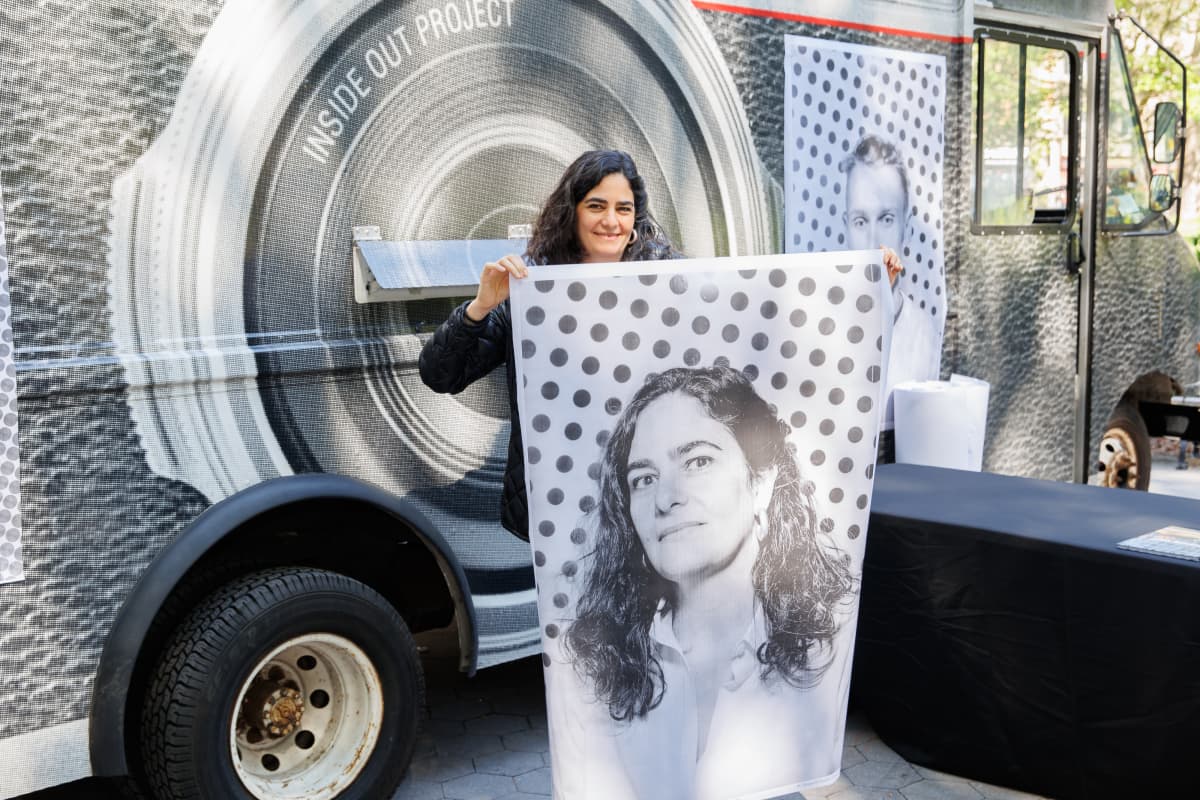
To call attention to the climate change crisis, New York’s American Museum of Natural History is teaming up with French artist JR on an installation of photographic portraits titled “Portraits on Climate and Health: Dreams We Carry.”
The project is part of the museum’s growing efforts to put science and art in conversation, Jacqueline Handy, the museum’s director of public programs, told me. “It’s connecting with folks and I think will reach people in a way that we haven’t before.”
JR’s “Inside Out Project” set up shop outside the museum in Theodore Roosevelt Park with its photo booth truck last week. Over the course of three days, the truck captured 736 black and white images—my infant son and I were among several mom and baby double portraits—each printed out on the spot for participants.
The project also recorded 175 testimonies, with sitters sharing their thoughts about climate change and the risks it poses to our planet and civilization.
A long line of people waiting to take their portrait with JR’s “Inside Out Project” photo booth truck for “Portraits on Climate and Health: Dreams We Carry” at the American Museum of Natural History in New York. Photo by Alvaro Keding, ©AMNH.
“It’s just saying that we are all impacted by climate change and we can all be a part of the solution,” Handy said.
Many of the audio messages came from Indigenous filmmakers who are being featured in “The Wayfinders Film Series: Indigenous Wisdom Leading in the Climate Crisis,” another climate-themed event taking place at the museum for Climate Week NYC, taking place September 22–29.
The museum’s Climate Week events are also part of Canopy, an citizen art and science festival and network from Wellcome and Climate Group launching this month.
An installation of portraits taken by JR’s “Inside Out Project” photo booth truck for “Portraits on Climate and Health: Dreams We Carry” on view in the Ellen V. Futter Gallery at the American Museum of Natural History in New York. Photo by Alvaro Keding, ©AMNH.
It was an upbeat atmosphere outside the truck when I visited the truck, the late afternoon sun filtering through the trees on a beautiful late summer day. There was a long line of people waiting to get their photo taken, but they were cheering excitedly each time someone stepped outside of the photo booth and picked up their portrait.
“It seems like we bribed to New York to give us the best days of the year for this—folks have been in good spirits and really just want to participate,” Handy said.
A woman getting her portrait taken by JR’s “Inside Out Project” photo booth truck for “Portraits on Climate and Health: Dreams We Carry” at the American Museum of Natural History in New York. Photo by Daniel Kim, ©AMNH.
That’s often the case with the “Inside Out Project,” which JR launched in 2011 with his $100,000 winnings from the TED Prize. He wanted any community to be able to create their own versions of the large-scale black and white photographs he is known for wheat-pasting around the world.
To date, the project has held events in 152 different countries, taking over 560,000 portraits. Most of the time, a participating organization takes the photos themselves, and JR’s team edits, prints, and ships them back. But there are also “Inside Out Project” trucks based in New York and Paris, which have traveled to 18 countries, taking over 270,000 portraits at 122 different events.
“The ‘Inside Out Project’ is really a platform for people to spread all sorts of messages. So there’s been actions about climate change, but also about diversity, feminism, human rights, and other issues” Camille Rousselet, the project coordinator, told me. “The goal is really to give the tools to people to create their own art installations and spread their voices.”
An installation of portraits taken by JR’s “Inside Out Project” photo booth truck for “Portraits on Climate and Health: Dreams We Carry” on view in the Ellen V. Futter Gallery at the American Museum of Natural History in New York. Photo by Alvaro Keding, ©AMNH.
For “Portraits on Climate and Health,” those voices will be heard in two places in the museum. The walls of the museum’s 77th entryway (named after longtime former president Ellen V. Futter) have been papered over with select portraits from the projects, for an exhibition that officially begins September 23.
The full selection of images will be shown in a projection in the Richard Gilder Center for Science, Education, and Innovation—the cavernous new expansion that opened last year. And you can also check out all the portraits and the accompanying testimonials on the “Inside Out Project” website.
“Portraits on Climate and Health: Dreams We Carry” is on view at the American Museum of Natural History, 200 Central Park West, New York, New York, in the Ellen V. Futter Gallery, September 23–30, 2024; and in the Richard Gilder Center for Science, Education, and Innovation September 23–27, 2024.